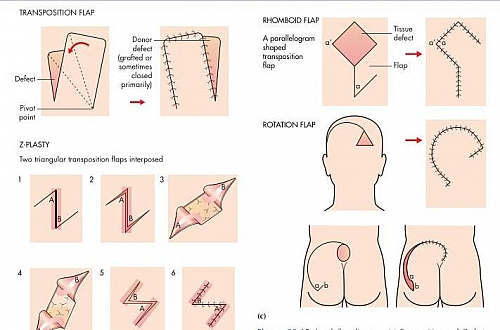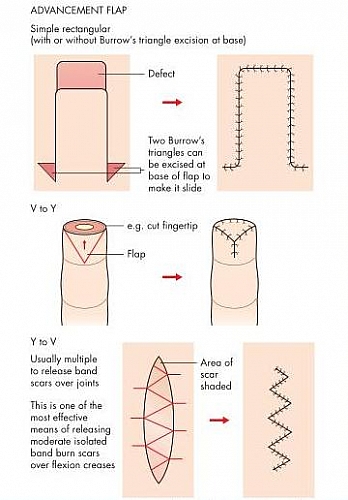Flaps in dermatology or surgery are body tissues transferred from donor sites to the recipient area with their blood supply. The part of a flap that contains the blood supply is called a Pedicle and serves as the base.
Table of Contents
Indications for making Flaps
- When a cover for a defect is needed, a skin graft may serve this function
- In order to restore the function of a damaged part of the body
- For cosmetics or aesthetics
- When there is a need to provide blood supply to a site with poor blood supply
Medical Importance
- They provide blood supply to the recipient site
- They provide tissue bulk at a defect
- They can provide sensation to the recipient site
- They have no contracture, are durable and the site can be re-explored for the secondary procedure without tissue loss
Disadvantages of Flaps
- Can cause fat deposit where it is not necessary
- May require multiple procedures such as in distal flap
Classification of Flaps
They can be classified into different types depending on the location, the type of tissue, blood supply, proximity to defect, and type of surgery. A list of the different types is shown below with explanations.
Types of Flaps according to Proximity of the Wound
- Local flap: this type of flap shares a side with the defect (wound). It is mostly used in reconstructive surgery for small facial defects
- Regional: this has near the wound but not adjacent to it
- Distant flap: this is away from the defect and it is done when local tissue is insufficient to cover an adjacent defect requiring a flap to be transferred from a remote location
- Free Flap: free tissue transferred to another site. To make a free flap, the arterial blood supply should be at least 1 mm in diameter. The microvascular anastomosis of the artery helps to restore the blood supply of the recipient site.
Classification according to Flap geometric design and method of transfer
- Advancement flap: subtypes include V-Y advancement flaps and bipedicle advancement flaps
- Transposition flaps: these include Z-plasty used for lengthening scars or tissues and the Rhomboid flap used for cheek, temple, back, and flat surface defects.
- Rotation flaps: these include basic rotation flaps and bilobed flaps. The Rotation flaps are used for convex surfaces such as the scalp, buttocks, and deltoid area of the shoulders.
- Interpolation flap
- Jumping flap
- Waltzing flap: this method is used for distal flap
- Free flap
The design and movement of these types from the donor to the recipient site depend on a balance of tension on tissue and blood supply as excessive tension leads to a decrease in blood supply which in turn leads to necrosis.
Advancement flap
This type capitalizes on the laxity of the constituent skin to provide excess tissue when separated from its underlying structures. It is mostly used in small defects where the skin is in excess and possesses an inherently good blood supply, such as in an aging face. It is also very useful for flexor surfaces but may need triangles excised at the base to make it work. These triangles are commonly called Burrows triangles.
Subtypes of advancement flaps
- V-Y flaps: in these, a small amount of length along the vertical axis is gained from the movement of tissue from the horizontal axis. The V-shaped flap is advanced and its donor site is closed to make the vertical limb of the Y. This is commonly used for fingertips and extremities (feet and hands).
- Bipedicle flap: This is a bucket-handle flap supplied from both ends that is useful to rebuild the lower eyelid in particular.
- Bilobed Flap: this uses a flap to close a convex defect, and a second smaller flap to close the donor site. They are useful to cover defects on the nose.
Classification according to the composition of tissue
- Simple: this consists of a single tissue. Examples include Cutaneous flaps (involving only the skin), Fascia flap (involving only the fascia), muscle flap (involving only the muscles).
- Composite: this has more than one type of tissue component. Examples include musculocutaneous flaps (combining muscle and skin tissue), osteo-cutaneous (combining bones and skin), or fascio-cutaneous (combining fascia and skin).
Muscle and myocutaneous flaps
Most parts of the skin get their blood supply from the underlying muscle, therefore understanding the vascular network of muscles helps you to transfer flaps of the muscles. This can be transferred alone (covered by a skin graft) or together with the overlying skin and subcutaneous tissue as well.
The pattern of blood supply to muscles determines how useful such a muscle maybe when used as a flap. Because of this, the vascular anatomy of muscles has been classified by Mathes and Nahai in terms of the number of pedicles, their size, and their point of entry.
The Mathes and Nahai classification allows the surgeon to predict the muscle’s reliability when used as a flap, its arc of rotation, or potential for free-tissue transfer. The reliable blood supply of muscles and their bulk allows them to obliterate dead space, account for the prominent role of muscle and myocutaneous flaps in reconstruction surgery.
Mathes and Nahai classification of muscle flaps
- Type I: the muscle flap has a single dominant vascular pedicle
- Type II: this has dominant proximal and smaller segmental
- Type III: this has two large dominant pedicles
- Type IV: a muscle flap with multiple vascular pedicles
- Type V: muscle flap with dominant pedicle at insertion and multiple segmental pedicles at the origin
Flaps according to the blood supply
- Random
- Axial
- Islanded or Pedicled
Random flaps
They bear no specific relationship to where the blood supply enters recipient tissue. They are made without regard to the underlying vascular anatomy, and their blood supply is based on the subdermal plexus of the donor tissue.
The length to breadth ratio of random flaps is roughly equal (normally a ratio of 1:1); sometimes the length to width ratio is 1.5:1 but can be lengthened beyond 1.5:1 through a process called delaying the flap whereby the flap is raised in stages to alter the blood supply before finally transferring the flap.
Axial flaps
These are longer than the random flaps and are preferred when a long flap is to be made. Large vascular pedicles supply these, remember that a pedicle is a base that contains the blood supply. The groin flap is an axial flap that is mostly used for hand reconstruction. Other types of axial flaps include the deltopectoral flap and the forehead flap.
Subtypes of Axial Flaps
- Pedicled (islanded) axial flaps
- Peninsular axial flaps
- Free flap
Pedicled flap (Islanded flap): This subtype can be swung around on a stalk or even fully islanded so that the business end of the skin being transferred can have the pedicle buried.




